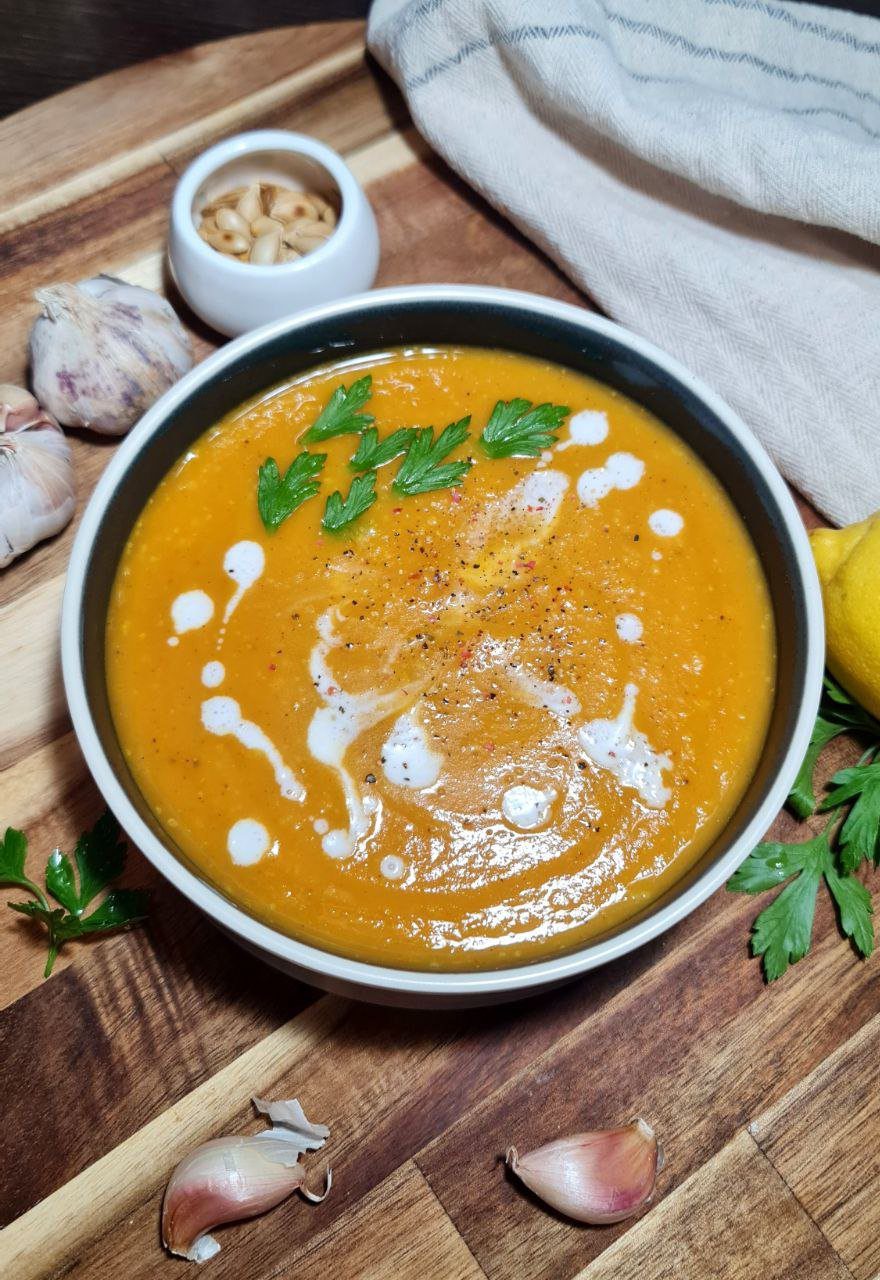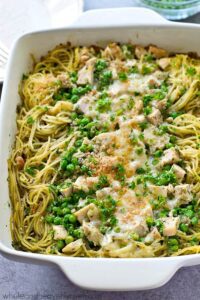Roasted Garlic Potato Soup a Cozy Bowl of Comfort is a delicious recipe that combines amazing flavors and textures.
There are few things more comforting than a bowl of creamy potato soup, and this roasted garlic version elevates the classic to new heights. The deep, caramelized flavor of roasted garlic transforms ordinary potato soup into an extraordinary culinary experience that warms you from the inside out. This soup represents the perfect balance of simplicity and sophistication, with humble ingredients coming together to create something truly special.
The magic of this soup lies in the transformation that occurs during roasting. Raw garlic’s sharp, pungent flavor mellows into something sweet, nutty, and complex when slowly roasted. This process caramelizes the natural sugars in garlic, creating depth of flavor that permeates every spoonful of the soup. Combined with the natural creaminess of potatoes, this creates a harmony of flavors that is both comforting and elegant.
The History of Potato Soup
Potato soup has humble origins as peasant food across Europe, where potatoes were a staple crop that could sustain families through harsh winters. In Ireland, potato soup often included wild herbs and whatever vegetables were available. In Germany, kartoffelsuppe typically features sausage and root vegetables. Eastern European versions might include dill and sour cream.

The addition of garlic to potato soup represents a more modern culinary evolution as garlic became more widely accepted in Western cooking. Historically, garlic was associated with peasant food and was often looked down upon by upper classes. It wasn’t until the 20th century that garlic gained widespread popularity in American cuisine, thanks in part to returning soldiers who had encountered it in European cooking during the World Wars.
The Science of Roasting Garlic
Understanding what happens to garlic during roasting helps explain why it transforms the soup so dramatically. Garlic contains alliin and alliinase enzymes that create allicin when raw garlic is crushed or chopped, responsible for its pungent flavor and odor. Heat deactivates these enzymes, preventing allicin formation and eliminating the sharpness.
Meanwhile, the heat catalyzes the Maillard reaction – a chemical reaction between amino acids and reducing sugars that creates hundreds of new flavor compounds. This reaction is responsible for the complex, savory flavors in roasted meats, baked goods, and indeed, roasted garlic. The natural sugars in garlic caramelize, creating sweet, nutty notes that balance the soup’s richness.
Ingredient Selection Guide
Potatoes: Starchy potatoes like Russets or Yukon Golds work best as they break down easily and create a creamy texture. Waxy potatoes like red potatoes will hold their shape better but result in a less creamy soup.
Garlic: Choose firm, heavy heads with tight, unbroken skin. Avoid garlic that’s sprouting or has dark spots. The size of garlic heads varies significantly – when in doubt, use three smaller heads instead of two large ones.
Broth: Homemade vegetable or chicken broth provides the best flavor. If using store-bought, choose low-sodium versions to control salt content. For non-vegetarian version, chicken broth adds depth.
Dairy: Heavy cream provides the richest texture, but half-and-half or whole milk can be substituted. For dairy-free options, coconut cream offers similar richness without dairy flavor.
Herbs: Fresh thyme is ideal, but dried works well too. Other herbs like rosemary or sage can be used, but use sparingly as they can overpower the garlic.
Technique Mastery
Roasting Garlic: Don’t rush the roasting process. Garlic should become deep golden brown and soft enough to squeeze from the papery skins. Under-roasted garlic won’t have developed full flavor, while over-roasted garlic becomes bitter.
Sweating Onions: Cook onions slowly over medium heat until translucent but not browned. This gentle cooking releases their sweetness without creating harsh caramelized notes that would compete with the garlic.
Simmering Potatoes: Cook potatoes until they’re falling-apart tender. Test by piercing with a knife – there should be no resistance. Overcooking is better than undercooking for creamy soup.
Blending: An immersion blender is ideal for creamy soups. If using a regular blender, work in batches and never fill more than halfway as hot liquid expands. Hold the lid firmly with a towel to prevent accidents.
Finishing: Add cream at the end and heat gently without boiling to prevent curdling. Adjust seasoning carefully – potatoes absorb salt, so you may need more than you think.
Flavor Development Secrets
For even deeper flavor, try these advanced techniques:
Double Garlic: Add a few cloves of minced raw garlic at the end for a flavor boost that complements the roasted garlic.
Umami Boost: Add a Parmesan rind while simmering for savory depth, or a teaspoon of white miso paste at the end.
Herb Infusion: Steep fresh herbs in the cream before adding to the soup for more pronounced herbal notes.
Wine Deglaze: After cooking onions, deglaze the pot with a splash of white wine for acidity and complexity.
Smoked Paprika: A pinch of smoked paprika adds depth and subtle smokiness that complements the garlic.
Texture Variations
While creamy smooth is classic, consider these textural variations:
Chunky Style: Reserve some cooked potatoes before blending, then add back at the end for textural contrast.
Toppings: Crispy elements like bacon, croutons, or fried shallots provide crunch against the creamy background.
Puree Consistency: For ultra-smooth soup, strain through a fine-mesh sieve after blending.
Potato Variety: Mix potato types – use starchy for creaminess and waxy for chunks that hold their shape.
Dietary Adaptations
This soup adapts beautifully to various dietary needs:
Vegan: Use olive oil instead of butter, vegetable broth, and coconut cream instead of dairy. Nutritional yeast can add cheesy flavor.
Gluten-Free: Naturally gluten-free when using certified gluten-free broth.
Lower Fat: Replace cream with evaporated milk or blended silken tofu for creaminess with less fat.
Dairy-Free: Coconut cream provides similar richness, or use cashew cream for neutral flavor.
Seasonal Variations
Adapt this soup through the seasons:
Spring: Add fresh peas and mint for brightness.
Summer: Serve chilled as vichyssoise, garnished with chives.
Fall: Incorporate roasted root vegetables like parsnips or celery root.
Winter: Add hearty greens like kale or spinach for added nutrition.
Serving and Presentation
Elevate your soup presentation with these ideas:
Garnish creatively: Swirl in herb oil, crème fraîche, or flavored butter just before serving.
Serve in bread bowls: Hollowed sourdough rounds make edible containers that add to the meal.
Temperature control: Serve in warmed bowls to keep soup hot longer.
Texture contrast: Offer various toppings in small bowls for custom garnishing.
Storage and Reheating
This soup stores beautifully, often tasting even better the next day as flavors meld. Cool completely before refrigerating in airtight containers for up to 4 days.
Freeze without dairy for up to 3 months. Add cream when reheating. To reheat, warm gently over medium-low heat, stirring frequently to prevent scorching. If soup becomes too thick, thin with additional broth or milk.
Note that potato-based soups can sometimes develop a grainy texture after freezing and thawing due to starch crystallization. This doesn’t affect safety but may change texture slightly.
Cultural Significance
Soup has always represented comfort and community across cultures. The act of sharing soup symbolizes care and nourishment. In many traditions, soup is what we offer to those who are sick, grieving, or in need of comfort.
Potato soup specifically represents resourcefulness – making something delicious from humble, affordable ingredients. This ethos of creating excellence from simplicity is at the heart of good home cooking across cultures and generations.
Final Thoughts
This roasted garlic potato soup represents more than just a meal – it represents comfort, care, and the transformative power of cooking techniques. The simple act of roasting garlic elevates ordinary ingredients into something extraordinary, reminding us that often the difference between good and great lies in patience and attention to detail.
Whether you’re making this soup to comfort yourself on a chilly evening or to share with loved ones, may it bring warmth and satisfaction to your table. The familiar comfort of potato soup combined with the sophisticated depth of roasted garlic creates a dish that satisfies both the body and the soul.

Roasted Garlic Potato Soup a Cozy Bowl of Comfort
Ingredients
Method
- Preheat oven to 400°F
- Slice top off garlic heads to expose cloves
- Drizzle with olive oil, sprinkle with salt
- Wrap in foil and roast for 30-35 minutes until soft and golden
- Let cool, then squeeze out softened garlic
- In a large pot, melt butter over medium heat
- Add onion and cook until translucent (5-7 minutes)
- Add potatoes, broth, and thyme
- Bring to boil, then reduce heat and simmer until potatoes are tender (15-20 minutes)
- Add roasted garlic to pot
- Using immersion blender, puree soup until smooth
- Stir in heavy cream and heat through
- Season with salt and pepper to taste
- Ladle into bowls
- Top with desired garnishes
- Serve with crusty bread for dipping



